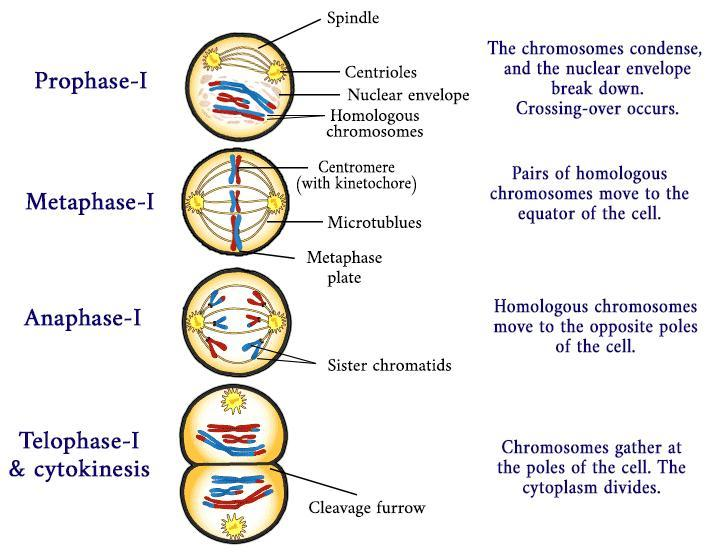
The function of meiosis-I is to separate
(a) Homologous chromosomes
(b) Parental chromosomes
(c) Sister chromatids
(d) Cross overs
Answer
564.9k+ views
Hint: Meiosis-I is known as reductional division because after meiosis occurs there is a decrease in the number of chromosomes in the daughter cells. Such a division is usually seen during alternation of generation i.e. from haploid to diploid body.
Complete Step by Step Answer:
Meiosis is a type of cellular division responsible for causing a change in the ploidy of cells. It is further divided into two types known as meiosis-I and meiosis-II. Meiosis-II is just normally mitosis taking place after meiosis-I. Meiosis-I occurs to separate the homologous chromosomes present and reduce the chromosome number. This separation occurs in the anaphase-I of meiosis-I where the chromosomes are separated by spindle fibers and moved to the poles on either side.

So, the correct option is ‘Homologous chromosomes’.
Additional information:
Let us study meiosis-I in more detail. Meiosis-I is divided into the following phases:
Prophase: Prophase is further divided into:
> Leptotene: Condensation of chromosomes begin
> Zygotene: Association of chromosomes known as synapsis
> Pachytene: Crossing over between two homologous chromosomes takes place
> Diplotene: Dissolution of the synaptonemal complex
> Diakinesis: Terminalization of the chiasmata
Metaphase: Bivalent chromosomes arrange themselves on the equatorial plane.
Anaphase: Separation of the homologous chromosomes
Telophase: Karyokinesis takes place followed by cytokinesis
Note:
- Chiasmata are known as the points of attachment still present between the homologous chromosomes even after the dissolution of the synaptonemal complex.
- Crossing over is responsible for recombination in the genome of cells which leads to variations in a species. These variations with time make way for the evolution of that species.
- Mitosis is known as equational division as the number of chromosomes remains the same in the daughter cells and the parent cell.
Complete Step by Step Answer:
Meiosis is a type of cellular division responsible for causing a change in the ploidy of cells. It is further divided into two types known as meiosis-I and meiosis-II. Meiosis-II is just normally mitosis taking place after meiosis-I. Meiosis-I occurs to separate the homologous chromosomes present and reduce the chromosome number. This separation occurs in the anaphase-I of meiosis-I where the chromosomes are separated by spindle fibers and moved to the poles on either side.

So, the correct option is ‘Homologous chromosomes’.
Additional information:
Let us study meiosis-I in more detail. Meiosis-I is divided into the following phases:
Prophase: Prophase is further divided into:
> Leptotene: Condensation of chromosomes begin
> Zygotene: Association of chromosomes known as synapsis
> Pachytene: Crossing over between two homologous chromosomes takes place
> Diplotene: Dissolution of the synaptonemal complex
> Diakinesis: Terminalization of the chiasmata
Metaphase: Bivalent chromosomes arrange themselves on the equatorial plane.
Anaphase: Separation of the homologous chromosomes
Telophase: Karyokinesis takes place followed by cytokinesis
Note:
- Chiasmata are known as the points of attachment still present between the homologous chromosomes even after the dissolution of the synaptonemal complex.
- Crossing over is responsible for recombination in the genome of cells which leads to variations in a species. These variations with time make way for the evolution of that species.
- Mitosis is known as equational division as the number of chromosomes remains the same in the daughter cells and the parent cell.
Recently Updated Pages
Why are manures considered better than fertilizers class 11 biology CBSE

Find the coordinates of the midpoint of the line segment class 11 maths CBSE

Distinguish between static friction limiting friction class 11 physics CBSE

The Chairman of the constituent Assembly was A Jawaharlal class 11 social science CBSE

The first National Commission on Labour NCL submitted class 11 social science CBSE

Number of all subshell of n + l 7 is A 4 B 5 C 6 D class 11 chemistry CBSE

Trending doubts
What is meant by exothermic and endothermic reactions class 11 chemistry CBSE

10 examples of friction in our daily life

One Metric ton is equal to kg A 10000 B 1000 C 100 class 11 physics CBSE

1 Quintal is equal to a 110 kg b 10 kg c 100kg d 1000 class 11 physics CBSE

Difference Between Prokaryotic Cells and Eukaryotic Cells

What are Quantum numbers Explain the quantum number class 11 chemistry CBSE




